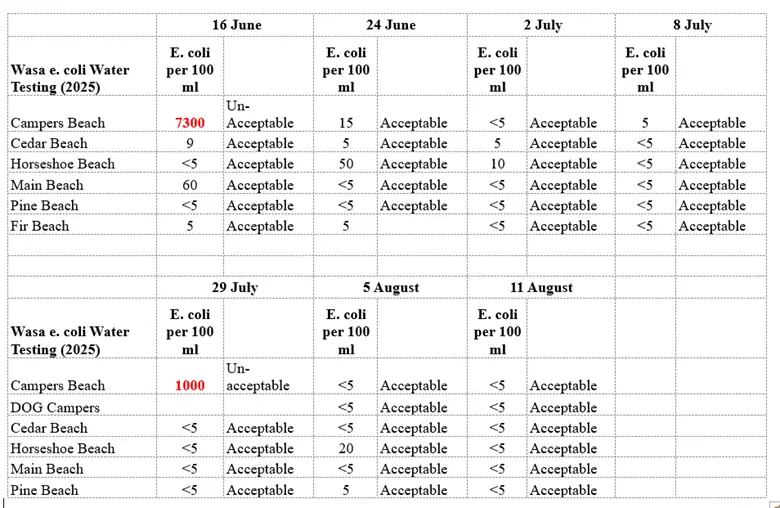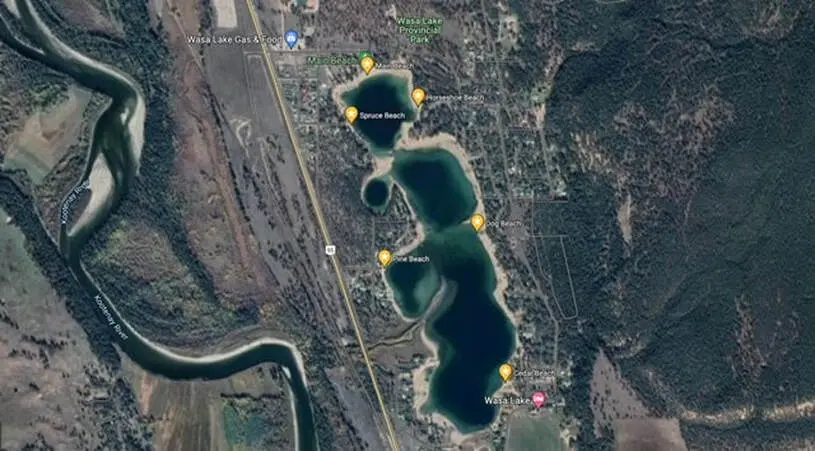Two recent spikes in E. coli readings from Campers Beach, one June 16 (7300 E. coli per 100 ml) and the other July 29 (1000 E. coli per 100 ml), have residents asking questions about what’s causing it, why it’s happening, especially before a long weekend? What’s the source? What can be done to fix it?
Here’s how E. coli testing at Wasa works.
Water samples are drawn from six locations – Main Beach, Horseshoe Beach, Campers Beach, Fir Beach, Pine Beach and Cedar Beach – and done every week, usually on a Monday or Tuesday morning, from mid-May to mid-September. Since the two high readings, WLLID has taken an extra water sample at Dog beach to compare results from there and Campers beach.
A WLLID volunteer draws water using a plastic bottle labeled with the location, date and time. The six samples are then submitted to the Public Health unit of Interior Health (IH) in Cranbrook. This facility receives water samples on Monday, Tuesday and Wednesday from 8:30am to 1pm. All other times, you’re out of luck.
Once IH (Cranbrook) has the samples, they are sent to a lab in Kelowna for analysis. IH will then report the results, at least three business days later, longer when there is a holiday, on their public website.
WLLID will also post the numbers on this page. However, by the time we receive the E. coli numbers, the water in the area has returned to a normal reading. As it did after both recent spikes in E. coli counts.
IH has a level of 235 E. coli per 100 ml of water that once crossed they start inquiring about possible events at the beach that may have caused the spike. This level has only been reached at Wasa once in the last 20 years. High E. coli levels are not typical at Wasa. This is the first summer where extremely high readings have occurred. They are specific to Campers / Dog beach. Both sites, post-29 July spike, have readings of <5 E. coli per 100 ml of water.
After the June spike, WLLID received emails reporting a high number of dogs on Campers beach and not staying within Dog beach boundaries as the possible cause of high readings.
Regarding the 29 July reading, discussions with IH Environmental Health officer covered what beach activities may have led to the high reading. Since the other 5 readings from around the lake were well within their historic range, IH suggested there was no need for a beach warning or closure. IH also added that one small, barely visible, flake of dog feces will cause the E. coli count to jump higher than normal.
BC Parks plays a role in communicating with beach users about high E. coli counts.
WLLID received an email from a resident who reported that on August 1, “Park staff came down to the beach shouting for everyone to get out of the water as it was unsafe and that everyone should go and have a shower immediately. They compared the event to a ‘shark sighting’ in a movie like Jaws. People were scrambling and obviously confused.”
To clarify WLLID’s role, we do not have jurisdiction over Park lands which means we do not place warning signs, close beaches or order people out of the water.
WLLID does its best to keep residents informed by posting E. coli and other water news on its website.
As a Board, we are five local residents who volunteer over 300 hours per year to running the organization, sponsoring Water Day, undertaking additional water testing for dissolved oxygen, temperature and chemical composition, investigating reported invasive species and monitoring algae and milfoil growth.
We understand that many people around Wasa receive their local news through Wasa Facebook forums. The WLLID Board has recently decided to move forward with establishing a Facebook page. Volunteer anyone?
WLLID has also received emails from residents who have suggested the source of high E. coli readings is septic system leakage from shore-front properties.
At this time, WLLID believes that septic leakage is not the cause of high E. coli readings. Other than the two recent high readings, all E. coli numbers from across the lake have been, this year and previous years, within historical ranges. The water is safe to swim in, be on and enjoy.
If septic systems were leaking, WLLID expects the E. coli numbers to be consistently higher in more than one location over more than a couple of samples.
Given WLLID’s lack of jurisdiction over Parks beaches and private property, we would like to see BC Parks and IH undertake a dye test of the septic system used at the pubic washroom at Campers Beach, and septic systems on private property to the North and South of Campers Beach.
These tests would provide evidence, one way or the other, of septic leakage. WLLID will keep pushing for Parks and IH to undertake these tests.




